Magnus Carlsen Favorite Chess Openings

There is no doubt that Magnus Carlsen is one of the greatest chess players of all times. What is very unique about him is his huge ability to grind a win out of very tiny advantages. He has a universal playing style that puzzles his opponents and a machine-like ability to calculate deeply in very complicated positions!
In this article we will discuss some of his games where he showed great opening preparations, middle game skills and a brilliant endgame technique. His talent as a young boy rocked the world after his famous draw with the Legendary Garry Kasparov at the age of 14. Everyone started speaking about the mysterious and talented boy from Norway and feared to play against him!
Our first game would be the 14 years old Magnus Carlsen against Garry Kasparov. For Carlsen, it was a great chance to prove himself against the best chess player in the world at this time. He knows Garry Kasparov has a legendary opening preparation. He avoids Kasparov favorite opening the Sicilian Najdorf all together by playing 1.d4 thus making the game less theoretical and making sure to not get caught into one of Garry’s brilliant opening analysis.
Magnus Carlsen vs Garry Kasparov
1.d4 d5 2.c4 c6 3.Nf3 Nf6 4.Nc3 e6 5.Bg5 Nbd7
The sharp alternative is 5…dxc4 , known as the Botvinnik System. Kasparov is using the correct strategy of not going into sharp variations against a child who calculates like a computer!
6.e3 Qa5
Kasparov plays the Cambridge Springs variation, which is not as volatile as the Botvinnik variation.
7.Nd2 Bb4 8.Qc2 0–0 9.Be2 so far all theory
9…e5!?
Well known approach. The alternatives is 9…dxc4 but Kasparov prefers the dynamic play, quickly opening up the center to exploit white lag in development.
10.0–0 exd4 11.Nb3!
a necessary move. If white plays the horrible 11.exd4 the simple 11…dxc4 is a discovered attack on the g5 bishop which forces white to either give up the bishop pair in an open position or lose a pawn for nothing.
11…Qb6 12.exd4 dxc4 13.Bxc4
Now the position is fairly equal, white has a weak pawn on d file, however he has more free play with his pieces and some prospects to attack black king, black has less space and he needs to figure out a plan to pressure white before his king gets under attack.
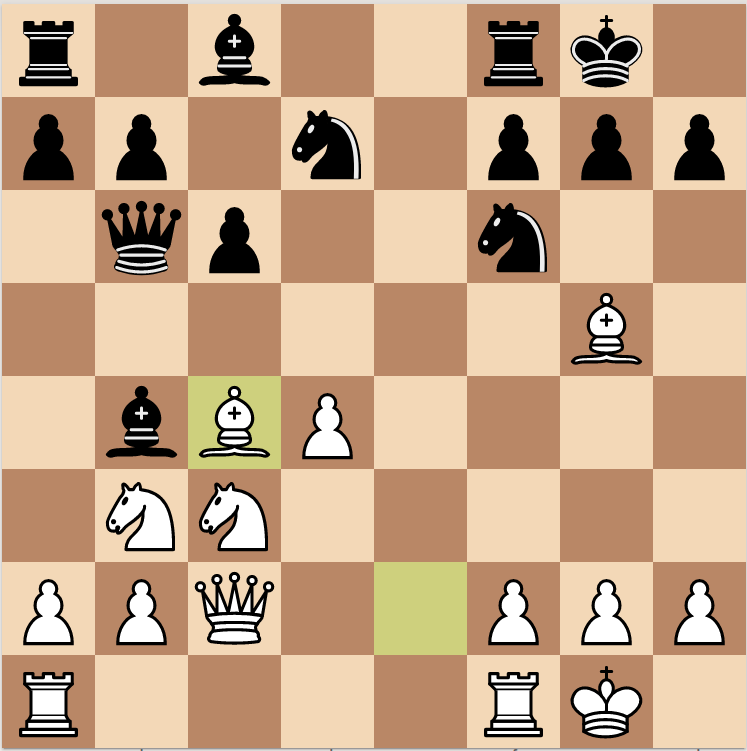
13…a5!? trying to disrupt white coordination on the Queen Side
14.a4 Qc7 15.Rae1 h6 16.Bh4 Bd6 17.h3 Nb6
A blunder would be 17…g5 18 Qg6+ !
18.Bxf6 Nxc4 19.Ne4 Bh2+
A slightly better variation for Black would have been 19…Be6 20.Nxd6 Nxd6.
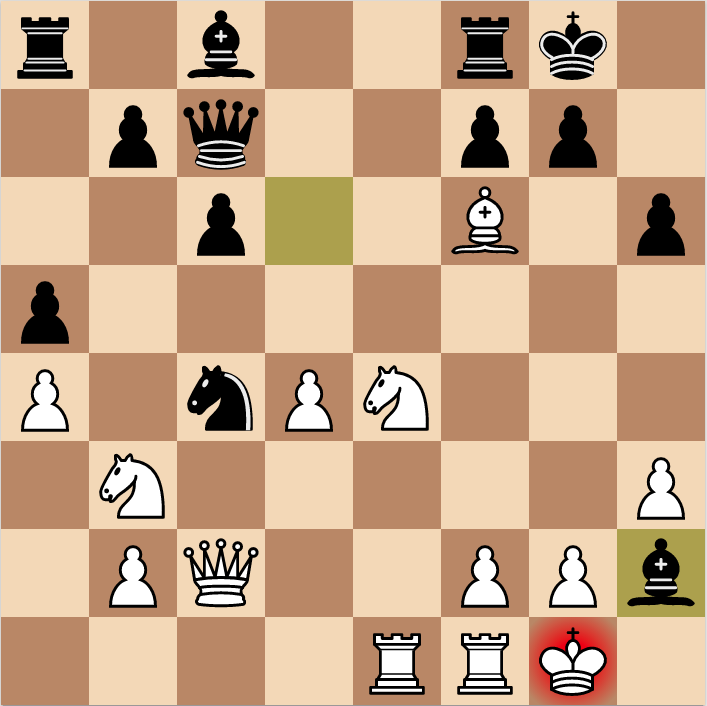
20.Kh1 Nd6 21.Kxh2 Nxe4+ 22.Be5 Nd6 23.Qc5
23.d5! Rd8 24.Nd4 wins a pawn, because 24…Bd7 loses to 25.Nb5
23…Rd8 24.d5 Qd7 25.Nd4 Nf5 26.dxc6 bxc6 27.Nxc6 Re8 28.Rd1 Qe6 29.Rfe1 Bb7 30.Nd4
Wow, the kid has Kasparov sweating, but he sees that after 30.Nxa5 there are enormous complications arising from 30…Bxg2 When you are a pawn up against the world’s strongest player you do not want to give him this kind of counterplay, but rather to simplify the position and win in the endgame.
30…Nxd4 31.Qxd4 Qg6 32.Qg4
When you are a pawn up and have opposite colour bishops it is usually better to keep the queens on the board. I would have have played 32.f3.
The remainder of the game is a opposite-coloured Bishop, leading to a draw.
32…Qxg4 33.hxg4 Bc6 34.b3 f6 35.Bc3 Rxe1 36.Rxe1 Bd5 37.Rb1 Kf7 38.Kg3 Rb8 39.b4 axb4 40.Bxb4 Bc4 41.a5 Ba6 42.f3 Kg6 43.Kf4 h5 44.gxh5+ Kxh5 45.Rh1+ Kg6 46.Bc5 Rb2 47.Kg3 Ra2 48.Bb6 Kf7 49.Rc1 g5 50.Rc7+
A possibly better idea was 50.Bd8! Bb5 51.Rd1 Bc4 52.Rd6 Bf1 53.f4 Rxg2+ 54.Kf3 gxf4 55.Rxf6+ Ke8 56.Bc7 Ra2 57.Rxf4 Kd7 58.Bb6 that is still a draw, but with a little more suffering for Black.
50…Kg6 51.Rc6 Bf1 52.Bf2
And draw agreed. Kasparov was lucky to escape with it!
You can now rewatch the entire game in my LiChess study:
When it comes to Carlsen playing the black pieces, he doesn’t believe in playing for a draw. He always tries to find the way to counter attack and get the white player under pressure. Our next game is another display of 14 years old carlsen‘s perfect endgame technique!
Davor Palo vs Magnus Carlsen
1.d4 Nf6 2.c4 e6 3.Nc3 Bb4
choosing the nimzo indian one of the most straightforward ways to answer 1-d4 and play for a win!
4.Qc2 0–0 5.a3 Bxc3+ 6.Qxc3 b6 7.Bg5 Bb7 8.Nf3 d6 9.Nd2 Nbd7
10.f3 White wants to occupy the center and take huge space advantage with e4 d4 c4 pawns. However, black has so many ways to counter attack it right from the start
10…c5!?
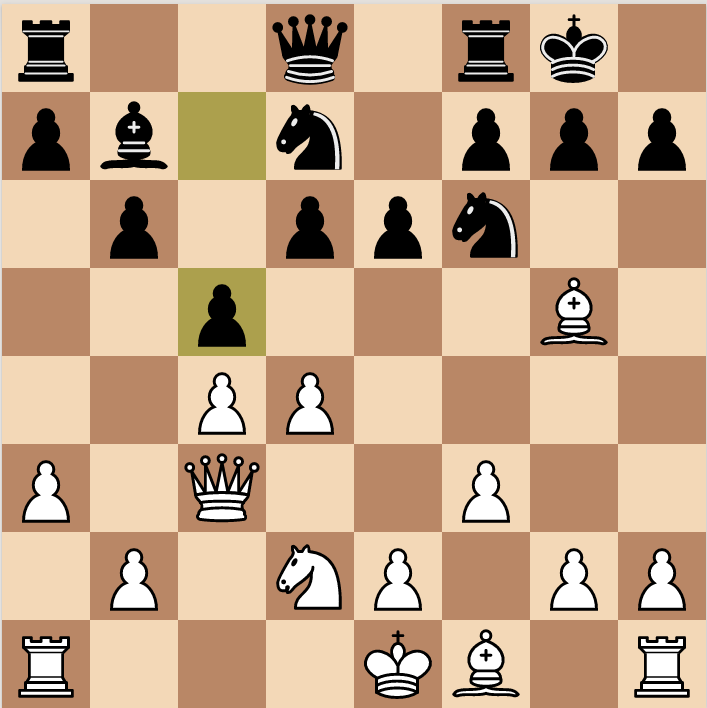
Besides this move black has two alternatives:
- 10…h6!? forcing white to decide what to do with the bishop.either give up the bishop pair advantage by Bxf6 or retreating to a less active square.
- 10…d5!? disrupt white plan to occupy the center and prevent e4 from being played (11.e4?! dxe4 12.fxe4 h6! and white has to give up the bishop for a knight in a open position or just lose a center pawn)
11 e4
white main idea, other alternatives are not good enough. For example 11.dxc5 dxc5 12.e3 h6! 13.Bh4 e5 14.Qc2 e4! snd black is starting to open the game really quick while white king is still in the center and his pieces are underdeveloped.
11…Re8 12.Bd3
12…cxd4!N A novelty at that time, and a good one!
Previous games which had reached this position continued as follows: 12…Qc7!? okay-ish move but a bit passive and 12…e5 13.d5? (13.dxe5!? dxe5 14.0–0) 13…Nf8?! (13…Nxd5! 14.Bxd8 Nxc3 15.Bc7 Na4) 14.Qc2 Bc8 15.Nb1 h6 16.Be3 Nh5 17.g3
13.Qxd4 Nc5 14.Bc2
Or 14.0–0 e5 15.Qe3 h6 16.Bxf6 (16.Bh4 Ng4) 16…Qxf6 17.b4 Ne6 18.Nb3 Nf4 19.Rfd1 and I would say black completely equalized and has equal chances while white is stuck with bad bishop and has no plan.
14…e5!
Closing the center and making sure that white light square bishop stays bad for a long time!
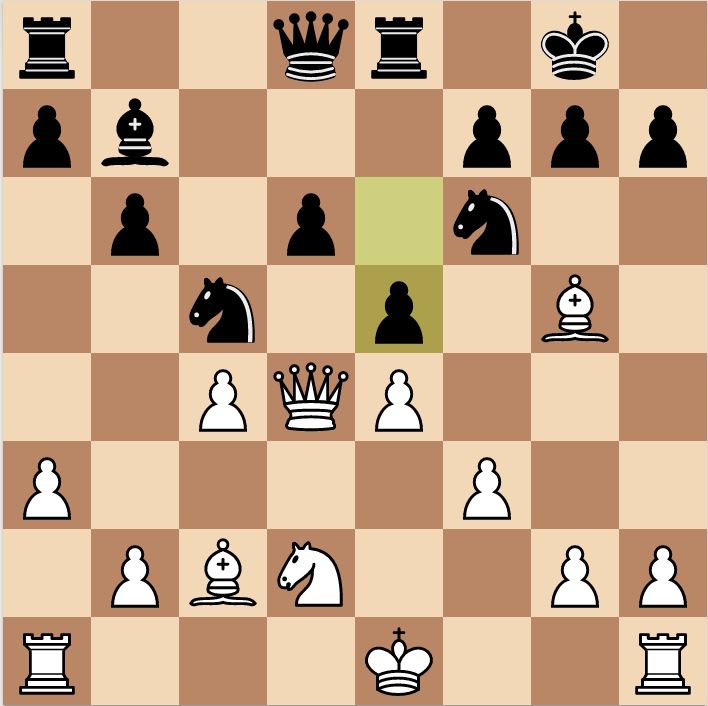
15.Qf2 Ng4!?
A deep strategic move. White has a bad bishop and more space, while black would like to go into the endgame where he could exploit all the weakness in white position due to over extended pawns.
White accepts the challenge to play the endgame, but it was better to play 16.Qh4 f6 17.Qxg4 fxg5 18.h4 gxh4 19.Qxh4 Qxh4+ 20.Rxh4, and white has some play on the h file and the kingside that could ensure a fighting chance for him.
16.Bxd8 Nxf2 17.Kxf2 Rexd8
The position has become simpler, and now with such structure of the pawns White doesn’t have even the minimal positional advantage.
18.b4 Ne6 19.Rhc1 19.Nb3!? Rac8 20.Bd3 Nf4 21.Bf1 followed by g3 and white may be OK here
19…Kf8 Black remembers that his king is a very important piece in the endgame!
20.Nb3 Ke7 21.Bd3 Bc6 22.a4?! It’s very careless easing of point “b4”. Now considerably wins in force the following move of Black.
22…a5! 23 bxa5 Nc5!
Probably, White have missed this beautiful resource, because only hoped on 23…bxa5? 24.c5 dxc5 25.Nxc5 Nxc5 (25…Nf4 26.Bf1 Rd2+ 27.Ke3 Rad8 28.g3 Ng2+ 29.Bxg2 Rxg2 30.Nb3) 26.Rxc5 Rxd3 27.Rxc6 Rd2+ 28.Kg3=
24.Bc2 Or 24.Nxc5?! dxc5 (24…bxc5 25.Bc2 Rxa5 26.Rcb1 Rda8 27.Ra3) 25.Ke3 (25.axb6? Rxd3 26.a5 Rd2+ 27.Kg3 Ra6 28.Rcb1 Bb7) 25…Rxa5 with obvious positional advantage of Black.
24…bxa5 25.Rcb1 Kd7! With the idea Kc7, covering the point “b6”.
26.Nxc5+ dxc5 27.Rd1+ Kc7 28.Rxd8 Rxd8
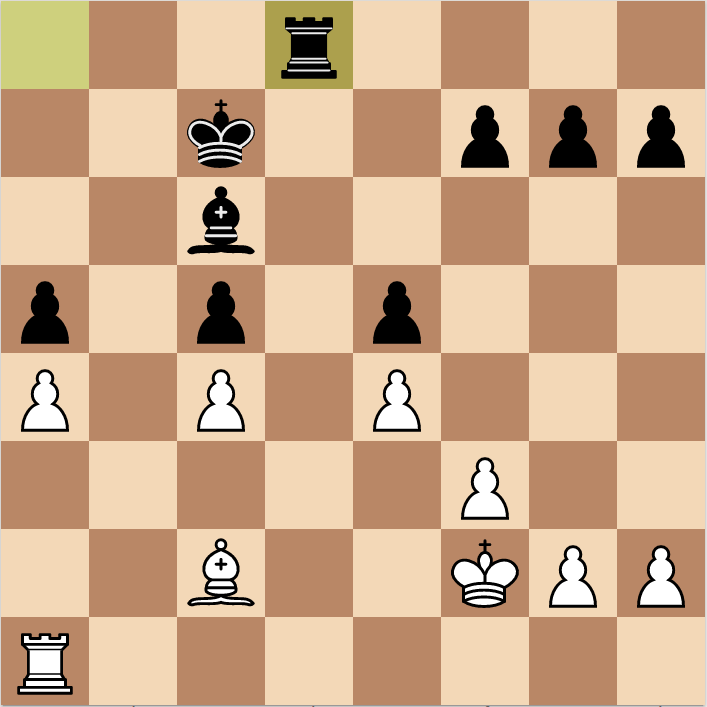
This position is a typical example of a good bishop against a bad bishop, an active rook against a slightly passive rook and total control of the open files and squares. Psychologically speaking, it is very hard for a white player to be defending such a position as he studied before these typical ideas and he knows it is an easy win for the black side.
29.Ke3 Rd4 30.Bd3 Bd7 31.Rb1?! Bad timing for an active move!
31…f5! Opening a second front
32.Rc1 32.exf5?? Rxd3+ 33.Kxd3 Bxf5+ ends the game immediately
32…f4+ 33.Ke2 Rd6 Black’s rook has finished its mission on d4.
34.Rb1 Rh6! 35.h3 Now White have lost a counterplay connected with progress “g3”.
35…Rg6 36.Kf2 Rd6 37.Ke2 g5 38.Bc2 h5 39.Rd1 Rd4 40.Bd3 Rd6 41.Bc2 Rd4 42.Bd3 Bc6 43.Rg1 Rd8
A maneuvering stage, and Black provokes movements of g2 with the purpose to create of weakness in camp of the contender.
44.g3 Rg8! 45.gxf4 Or 45.g4 hxg4 46.hxg4 Rb8! and a4 and f3 are just too weak.
45…exf4 46.e5 Fishing for any little activity.
46…Bd7 47.Bh7 Rg7 48.Be4 Bxh3 49.Rh1 g4 The game is practically over.
50.Rb1 Rg5 51.Rb7+ Kd8 52.e6 Re5 53.Rf7 g3–+ 54.Rxf4 Rg5 55.Bd5 Bxe6!? 56.Kf1 Bxd5 57.cxd5 Rxd5 58.Kg2 Rd4 59.Rf5 h4 60.Kh3 c4 0-1
This beautiful endgame is worth watching and rewatching. It teaches a lot about how to fight against a bad bishop.
Our last game is a very recent one played in May 2020! Against one of the top 10 in the world, Alexander Grischuk. It shows how far Magnus has gone in his Opening Preparation and why he is the number one player in the world!
Magnus Carlsen vs Alexander Grischuk
1.e4 e5 2.Nf3 Nc6 3.Bb5 Nf6 4.d3 Bc5
5.Bxc6 playing a simple variation in rapid games where you can just play chess is always a good idea
5…dxc6 6.Nc3 0–0 7.Be3 Bd6 8.Bg5 Qe7 9.h3 Re8 10.g4 Qe6 11.Nh4 Nd7
White delays castling and keeps all his options open. He can castle queenside or even play Ke2 keeping his king in the center because it is safe there and due to the exc6 capture in the opening. Black doesn’t have any easy way to break white central control.
12.Nf5
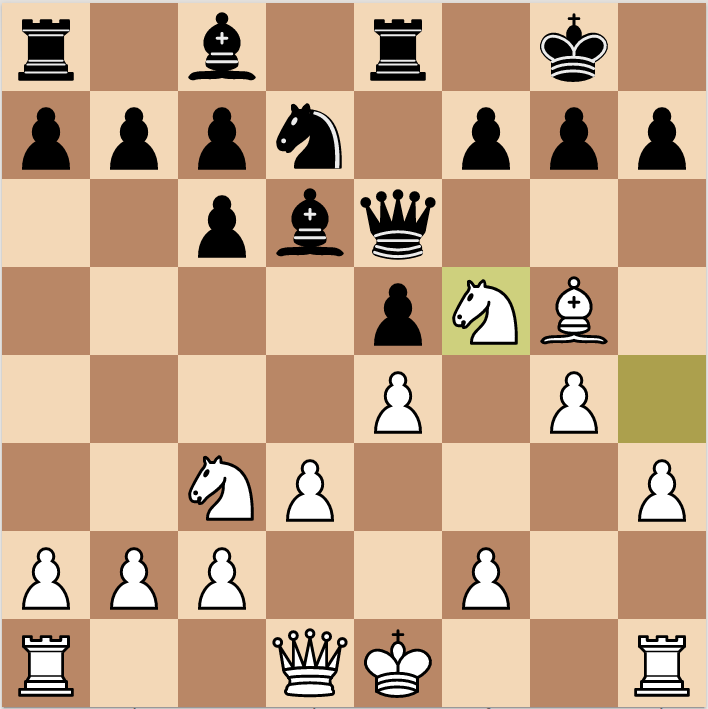
12…Nc5 13.h4 Bf8 14.h5
Black problem is the lack of a counterplay. He must react to white threats. This is a very bad sign in chess and can be deadly in rapid and blitz games.
14…f6 15.Be3 Qf7 16.f4 exf4 17.Bxf4 b5 18.Qf3 Ne6
Perhaps 18…b4 19.Ne2 a5 was a better try to dislocate white pieces a bit. The problem is that White is much faster on the kingside.
19.Be3 Bb7 20.0–0–0 b4 21.Na4 c5 22.h6 g6 23.Ng7
What an annoying move! White is threatening to exchange black best piece which is the knight on e6 removing a vital defender of the c5 pawn. Black moves are pretty much forced here.
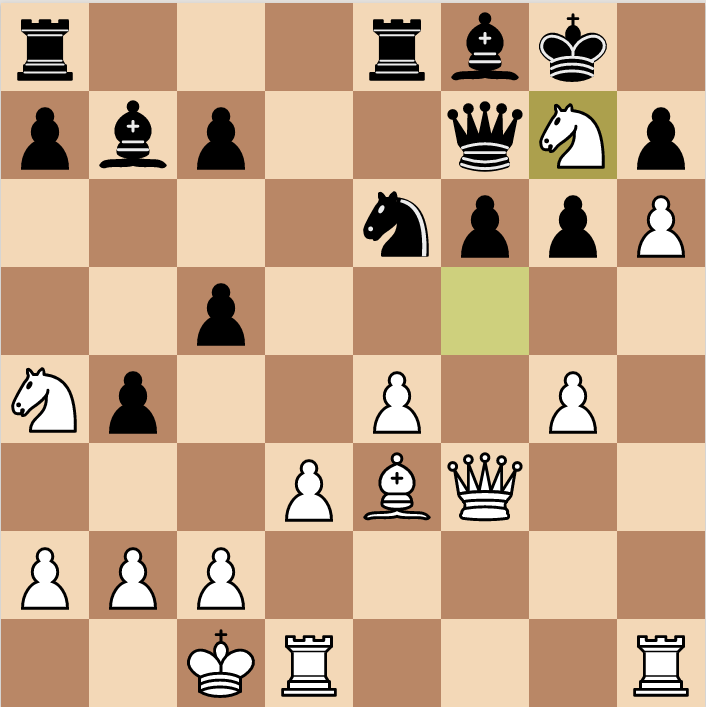
23…Bxg7 24.hxg7 c4 25.Nc5 Nxc5 26.Bxc5 cxd3 27.cxd3 a5
this is an opposite color bishops middle game where black king is totally uncomfortable while white king is out of the action.
28.Bf8?! Rxf8! Black happily gives up the exchange for a pawn easing the pressure on his king. However in a rapid game, White plan now is so simple: exchange all pieces and get to an endgame with bishop against rook easily wins.
29.gxf8Q+ Rxf8 30.Kb1 Qd7 31.Rc1 a4 32.Qe3 Rf7 33.Rc4 b3 34.a3 Qxg4 35.Rxa4 f5??
The last move is a very difficult to spot blunder! Black understandably wants some counter play. The problem is that he isolates his queen from the defense of his pieces and white quickly exploit this.
36.Rd4 fxe4 37.Rd8+ Rf8 38.Rxf8+ Kxf8 39.Qc5+ Ke8 40.Qxc7 Bc8 41.Qe5+ Kd8 42.Qh8+ Kc7 43.Rxh7+ Kc6 44.Qc3+ Kd6 45.Qd4+ Ke6 46.dxe4 1-0
Black has no counterplay and the mating net is set around the exposed black king in the center. Black resigned!
And here’s the whole game to replay.
Conclusions
In this article we have explored the favorite chess openings of World Champion Magnus Carlsen. In reality, Magnus really like to change his opening systems a lot, especially against “weaker” player. He strongly favors the positional approach, when he grinds down the opponent and spills water out of stones. But he’s also fantastic at calculation, which means he’s ready for the sharp opening lines as well.
In this article we saw examples of the Spanish Opening, the Nimzo-Indian defense and the Queen’s Gambit Declined, in which he player top-class players, including Garry Kasparov, and showed how succesfull his approach to the opening strategy is.
Have fun!!